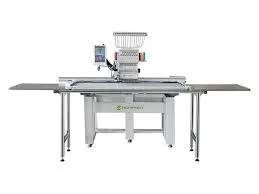Dec . 10, 2024 23:49 Back to list
Innovations in Computerized Embroidery Machines for Enhanced Precision and Creativity
The Evolution of Embroidery Machines Merging Tradition with Technology
Embroidery is an age-old art form that has been cherished across cultures for centuries. From intricate patterns adorning royal garments to simple stitches on everyday attire, the craftsmanship involved in embroidery has remained a testament to human creativity. However, with the advent of modern technology, the traditional methods of embroidery have evolved significantly, leading to the development of advanced embroidery machines that integrate sophisticated computer systems. This article explores the impact of computer technology on embroidery machines and how it has transformed the industry.
The Traditional Art of Embroidery
Historically, embroidery was a labor-intensive process that required immense skill and patience. Artisans would painstakingly create designs by hand, using needles and threads to bring their visions to life. This method, while incredibly rewarding, often limited the complexity and scalability of embroidered designs. As societies evolved and industrialization took hold, the need for efficiency and precision in textile production became apparent.
The Birth of Embroidery Machines
The first embroidery machines were introduced in the 19th century, primarily to automate the stitching process. These machines utilized mechanical components to execute basic stitching tasks, which significantly increased production speed compared to hand embroidery. However, the possibilities were still limited by the machines' designs and the operators' skills. As demand for custom embroidery grew, the need for more advanced solutions became evident.
The Rise of Computerized Embroidery Machines
The introduction of computer technology in the late 20th century marked a turning point for the embroidery industry. Computerized embroidery machines, equipped with advanced software, allowed users to create intricate designs with ease. These machines can store thousands of designs in their memory, enabling users to switch between patterns swiftly without the need for manual setup.
One of the major advantages of computerized embroidery machines is the ability to use various fonts, shapes, and colors. Users can input their designs through software applications, which translate the digital image into a format that the embroidery machine can execute. This level of precision and customization was unprecedented and opened up new avenues for artists, designers, and businesses alike.
embroidery machine computer

Efficiency and Creativity
With the combination of embroidery machines and computer technology, the efficiency of production has dramatically increased. What once took hours or even days for an artisan to create can now be completed in a fraction of the time. This efficiency has lowered costs for businesses and enabled them to cater to a broader audience. Custom embroidery shops can now fulfill orders more quickly, while fashion designers can incorporate embroidery into their collections more seamlessly.
Moreover, the creative possibilities are virtually limitless. Designers can experiment with bold patterns, intricate details, and a plethora of colors, resulting in unique and innovative works. This synergy between technology and creativity has led to a resurgence of interest in embroidery for both personal and commercial projects.
The Future of Embroidery Technology
As technology continues to advance, the future of embroidery machines looks promising. Innovations such as artificial intelligence and machine learning may further enhance the capabilities of these machines. Soon, embroidery systems may be able to learn from user preferences, providing personalized design suggestions and automating even more aspects of the embroidery process.
In addition, the rising trend of sustainable and ethically produced fashion may influence the design and function of embroidery machines. As consumers become more aware of the environmental impacts of their choices, the demand for eco-friendly embroidery techniques may lead manufacturers to develop machines that utilize sustainable materials and practices.
Conclusion
The integration of computer technology into the world of embroidery machines has dramatically transformed the landscape of this traditional art form. By merging the timeless beauty of embroidery with modern technology, we have ushered in a new era that balances efficiency, creativity, and artistry. As we look to the future, one can only imagine the exciting possibilities that await in this ever-evolving industry. Whether for personal expression or commercial use, computerized embroidery machines have undoubtedly reshaped how we create and appreciate embroidered art today.
-
Affordable Commercial Embroidery Machines for Sale
NewsAug.01,2025
-
Top AI Embroidery Machine Manufacturers | GPT-4 Turbo Tech
NewsJul.31,2025
-
Affordable Computer Embroidery Machines | Best Prices
NewsJul.31,2025
-
Cheap T Shirt Printing Embroidery Machine with Multi Needle Efficiency
NewsJul.30,2025
-
High-Quality T Shirt Embroidery Machine – Multi & 12/15 Needle Options
NewsJul.30,2025
-
High-Efficiency Computerized T Shirt Embroidery Machine for Custom Apparel
NewsJul.29,2025

Copyright © 2025 Xingtai Pufa Trading Co., Ltd All Rights Reserved. Sitemap | Privacy Policy
